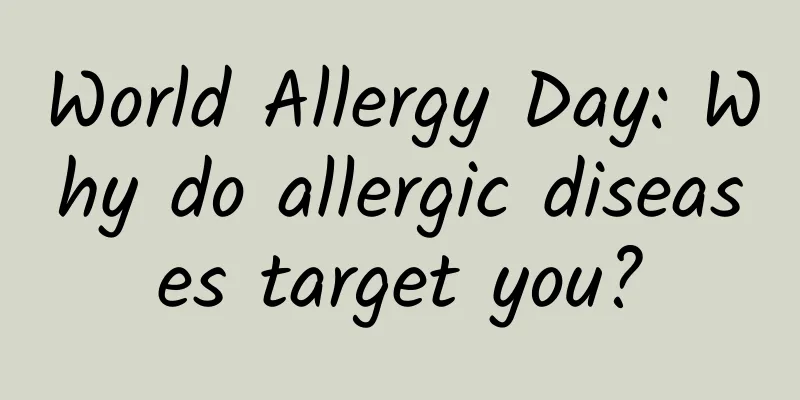World Allergy Day: Why do allergic diseases target you?

|
July 8, 2020 is the 16th World Allergy Day. What are allergic diseases? Why are some people "targeted"? So, what should we do if we have allergies? Today, Yang Bilian, chief physician of the Department of Dermatology at Beijing University of Chinese Medicine Oriental Hospital, will explain the knowledge of allergic diseases to everyone. Why do allergic diseases target you? First, let us understand what allergic diseases are. Allergic diseases, also known as allergic diseases, are abnormal immune responses caused by allergens, leading to tissue inflammation or organ dysfunction. They can occur at all ages and are common and frequently occurring diseases in dermatology. Summer is the peak season for allergic skin diseases, so why do they occur? Genetic factors Genetic factors, commonly known as "allergic constitution", doctors often ask whether your close relatives also suffer from related allergic diseases. However, not all patients with allergic constitution will develop the disease, which is closely related to individual differences such as their own immunity. Allergens Allergens are the most common causes that everyone knows. Most of them enter the body through skin contact, inhalation, ingestion or injection. They mainly include animal fur, poisonous hairs of insects, flowers, fruits, ultraviolet rays, inhalation of pollen, dust mites, ingestion of seafood, fish and shrimp, injection of drugs and vaccines, contact with metal products, daily detergents, cosmetics, paints, gasoline and other chemical raw materials. This is why doctors will involve the patient's occupation, recent whereabouts and activities when asking patients, which is helpful for the diagnosis of the disease. Doctors choose appropriate examination methods to identify allergens based on the cause, symptoms and morphology of skin lesions, rather than generalizing. In simple terms, blood draws are generally used for serum allergen-specific IgE testing for pollen, dust mites, molds, foods, etc., but for housewives' hands, long-term occupational exposure to chemicals, long-term difficult-to-heal dermatitis and eczema, patch tests are required to further clarify the cause. Environment, Lifestyle For example, if pollutants such as formaldehyde are produced indoors, they may be related to the onset of atopic dermatitis. In addition, modern lifestyles pay more attention to hygiene. For example, some patients say, "I take a bath twice a day and I love cleanliness, so why do I still have allergies and rashes?" In fact, excessive bathing is more likely to damage the skin barrier and cause the body's immune system to be unbalanced, which is why urban people are more likely to have allergies than rural people. Secondly, social factors such as staying up late and high work pressure are also one of the causes. What should I do if I have allergies? Through these common symptoms, patients can have a preliminary understanding of their disease and treatment. For those with mild symptoms, patients can quickly relieve the symptoms by immediately separating from the substance that causes allergies; for those who cannot clearly identify what they are allergic to or whose allergic symptoms persist after separation, they should seek medical attention in time. The medication follows the principle that when exudation and redness and swelling are obvious in the acute phase, Chinese medicine decoction is used for wet compress or fumigation; if there is no erosion or exudation, lotions such as Sanhuang lotion and calamine lotion are used; in the subacute phase, there are scales and crusts, and oils such as lithospermum oil are used; in the chronic phase, infiltration, hypertrophy, and lichenification are used, and ointments such as Qingshi antipruritic ointment are used; in addition, oral antihistamines (such as loratadine or cetirizine hydrochloride, etc.) and topical topical hormones are used for anti-inflammatory and itching. In particular, the use of hormones must be used under the guidance of a doctor, and the principle of choosing hormones of appropriate strength and dosage form and gradually stopping the medication should not be abused, overused, or suddenly stopped; if the patient's rash area expands, itching, and blisters are severe, timely medical treatment is required to avoid delaying the condition. Pay great attention to serious and common allergic skin diseases Acute urticaria Patients often experience itchy skin first, and soon wheals appear at the itchy site, which are bright red or pale, of varying sizes and can merge into pieces. The skin is uneven, and the edema and wheals of the patient's epidermis usually subside within 24 hours, but new wheals are prone to recurring. Severe cases may be accompanied by symptoms of anaphylactic shock such as palpitations and low blood pressure. Respiratory symptoms include asthma and laryngeal edema, even difficulty breathing, fainting and suffocation. Gastrointestinal mucosal involvement may cause nausea, vomiting, abdominal distension, and diarrhea. Infection may cause systemic poisoning symptoms such as chills, high fever, and headache, especially fever up to 40°C. Because its onset is characterized by rapid onset in any part of the body, it is recommended that patients pay great attention to acute attacks or expansion of the area to prevent complications. Once the above discomfort symptoms occur, they must seek medical attention in an emergency, otherwise it will be life-threatening. Acute eczema Acute eczema is a common allergic skin disease that is difficult to treat. The skin lesions are mainly manifested by erythema, papules, papulovesicles, and blisters. Patients often have unbearable itching, and often form erosions and exudates due to scratching. Some patients have severe itching, which affects their daily rest and even causes neurological dysfunction, seriously reducing their quality of life. Severe scratching, hot water washing or other stimulation will also aggravate the skin lesions. If secondary infection occurs, pustules, pus crusts, swollen lymph nodes, and fever may form; it may also induce bacterial, fungal, and viral infections; it may also cause the skin lesions to merge with each other and spread throughout the body, forming diffuse flushing throughout the body, and even large areas of exudate and erosion, which will then develop into erythroderma, causing multi-system damage, affecting metabolism, and even endangering life. Therefore, after the onset of eczema, patients must cooperate with doctors and pay attention to nursing care. Do not wash with hot water or violent scratching to aggravate the condition. First, find the cause, find the allergen, and draw blood or do a patch test. Secondly, acute eczema is closely related to "dampness" and "heat", and dampness and heat are more common in the skin. The internal treatment is mainly to clear heat, promote dampness and relieve itching. According to the above principles, external treatment should be based on the above principles. When there is exudate, use decoctions of Sophora flavescens, Phellodendron chinense, Kochia scoparia, Dictamni cortex, Alum, Portulaca oleracea, etc. to clear heat, detoxify and relieve itching, or cold wet compresses with 10% Phellodendron chinense solution. When there is no exudate and only erythema, use Sanhuang lotion or calamine lotion for external use. In the acute stage, Chinese medicine internal treatment often uses buffalo horn, Rehmannia glutinosa, Cortex Moutan, Paeonia lactiflora, Nepeta tenuifolia, Saposhnikovia divaricata, Sophora flavescens, Scutellaria baicalensis, Folium Isatidis, Imperatae cylindrica, etc. to clear heat, cool blood, remove dampness and relieve itching. It can be combined with antihistamines or intravenous calcium infusion, vitamin C, compound glycyrrhizic acid glycoside and other anti-inflammatory and anti-allergic treatments. Drug rash The diagnosis of drug rash is mainly based on medical history and clinical manifestations. Except for fixed drug rashes with characteristic manifestations, most drug rashes are not easy to distinguish from the same symptoms caused by other reasons. A comprehensive analysis must be made based on the medical history and development process to make a judgment. In clinical practice, be alert to systemic, symmetrically distributed rashes that suddenly occur during treatment, inquire about the medication history, and pay special attention to cross-allergies to drugs and hidden forms of drug allergies. Be familiar with the characteristics of various types of drug allergies and exclude similar medical and dermatological diseases. Generally, drug rashes are brightly colored and itchy. Usually, drug rashes improve and subside quickly after discontinuation of the sensitizing drug. In clinical practice, drug rashes that occur after medication, disappear after discontinuation of medication, and recur when used again are of great diagnostic significance. Treatment principles for drug rash (1) Stop using all suspected allergenic drugs and drugs with similar structures. (2) Drink plenty of water or receive intravenous fluids to promote the excretion of drugs in the body. (3) Antihistamines, vitamin C and calcium supplements are given to patients with mild symptoms. Glucocorticoids are added to patients with severe symptoms. (4) Prevent and control secondary infections. (5) Supportive therapy, pay attention to fluid replacement and maintain electrolyte balance. For patients with mucosal damage, the mucosa should be actively protected, especially the conjunctiva of the eye, to prevent corneal turbidity and mucosal adhesion. Children should pay attention to the erosion of the glans and foreskin, which may cause foreskin stenosis. 3% boric acid water can be used for cleaning or corticosteroid eye drops every day. Keep the mouth clean and rinse frequently. 2% sodium bicarbonate solution can be used for rinsing. In short, whether it is acute eczema, drug rash, acute urticaria or other allergic skin diseases, especially people with allergic constitutions, must not ignore its hazards and impacts. The characteristics of skin diseases are that they are easy to diagnose and difficult to treat. They can have acute attacks and are difficult to heal repeatedly. Therefore, while receiving routine treatment from the doctor, you must actively adjust your care, remember not to scratch or scald, take fewer baths, pay attention to moisturizing and skin care, maintain a happy mood, detect early and treat early, and prevent aggravation or recurrence. |
<<: What is the crumbs sprinkled on the octopus balls (smoked bonito)?
>>: Tide, tide, tide! Say no to getting wet during the rainy season
Recommend
Precautions for ultrasound at 35 days of pregnancy
There is a time period for B-ultrasound testing. ...
Can papaya milk enlarge your breasts and quickly increase your cup size?
Many women like to eat papaya because one of its ...
The principle of Chinese medicine pulse diagnosis for boys and girls
Many women want to know whether it is a boy or a ...
The cervix has uneven echogenicity
People nowadays are very concerned about their ph...
Why am I losing weight during pregnancy?
After pregnancy, everyone will supplement a lot o...
Can I have sex with uterine fibroids?
Uterine fibroids are a common disease among moder...
Is it possible to remove oil from food?
Excerpted from: Inside and Outside the Classroom ...
Is it dangerous to be angry after a miscarriage?
No matter when, depression has a great impact on ...
How to remove the fishy smell of yak meat? How to eat yak meat
Yak beef can be made into beef jerky, and this me...
What to do if you have poor digestion during pregnancy
During pregnancy, women will experience some abno...
What is the reason for slow gestational sac development?
After the pregnancy is confirmed, the gestational...
When the autumn wind blows, the search for love is like the waves washing away the “sand”——Adenophora
The weather has started to cool down recently, wh...









